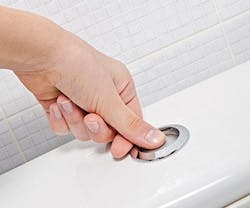Water Conservation 101
Restrooms
- A 1.28 gpf toilet uses 20% less than the standard 1.6 gpf.
- A low-flow faucet aerator that runs at 1.5 gpm can reduce water by 30% over traditional fixtures.
- Depending on their age, urinals can use 1-5 gallons per flush. Replace a 1.5 gpf urinal with a 0.5 gpf model and save over 4,600 gallons a year, according to WaterSense (a product label program by the EPA and similar to ENERGY STAR).
- For hotels and dormitories, use 2.0 gpm showerheads over the standard 2.5 models – users won’t notice the difference, but you will on your utility bill.
Landscaping
- Reduce your turf grass area, which is a large consumer of irrigation. Drought-tolerant plants and native vegetation are a good replacement because they require less water.
- Drip irrigation is 20-50% more water efficient than sprinklers.
- Maintain good soil quality, which retains moisture better.
- Group together water-intensive plants (hydrozoning).
- Add shut-off nozzles to spray heads to target leaks.
- Ensure water isn’t wasted on pavement areas.
- Avoid irrigation excess by using sensors and controls to manage your watering schedule and levels.
- Use permeable pavement, which allows stormwater to drain on your site and be filtered naturally instead of rushed toward storm sewers.
Pools and Spas
- Backwash filters only when necessary.
- Implement leak monitoring.
- Use a pool cover, which cuts down on evaporation loss.
- Evaluate the frequency of full pool drains.
Kitchens
- Choose a pre-rinse spray valve that uses 1.3 gpm or less.
- Replace old dish washers (both residential scale for small businesses and commercial grade for dining facilities) with new models that consume less water and energy.
- If possible, eliminate garbage disposals. Better yet, install a food pulper, which uses significantly less water to turn food scraps otherwise flushed down the drain into a valuable composting resource.
